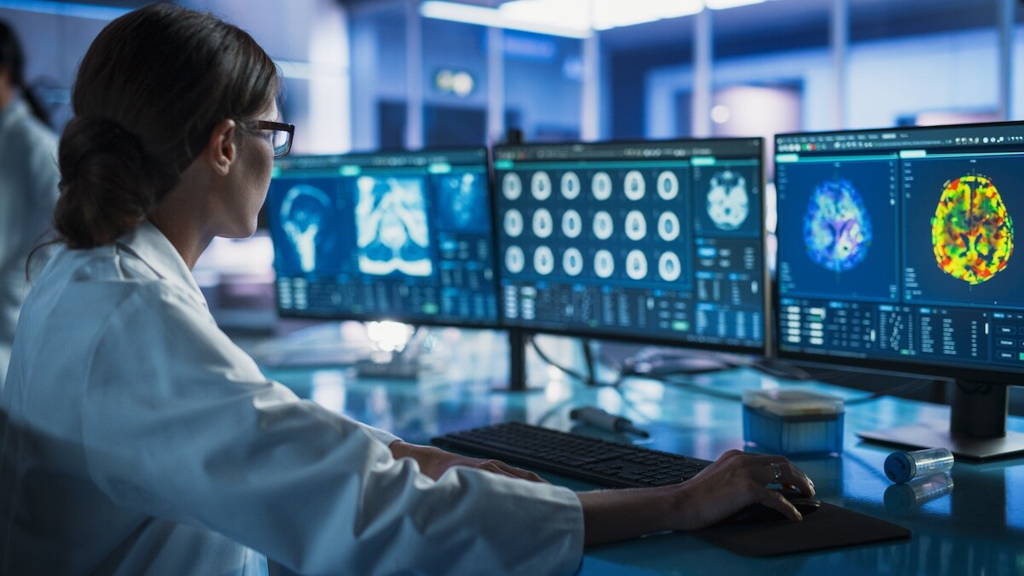New AI software, developed by a team of international researchers, can read and analyze brain scans of patients who have had a stroke twice as accurately. Thus, the exact time when the stroke occurred can be determined much more accurately. That information helps doctors decide whether the stroke can be treated successfully.
The researchers are hopeful that the new AI technology will eventually lead to faster and more accurate emergency treatment for patients who end up in the hospital with a stroke. Knowing when the stroke started is important because standard treatments only work in the very early stages after a stroke. Plus, when applied at a later stage, secondary damage can occur. So improving care after stroke is of great importance. This is being worked on on a global scale by Philips and Medtronic Neurovascular, among others, in collaboration with the World Stroke Organization. They are advocating for a global network of stroke care centers that can provide comprehensive care from early diagnosis to rehabilitation.
When did a stroke occur?
The AI software was developed by researchers at Imperial College London, the Technical University of Munich and the University of Edinburgh. The program addresses two of the biggest and most complex challenges in assessing stroke patients: identifying when the stroke started and whether the damage can be reversed.
The time elapsed after a stroke before treatment can be started determines which treatments may or may not work. In some cases, if started too late, a particular treatment method can actually do more harm than good. And determining exactly when a stroke occurred is very difficult. Some strokes may begin while the patient is asleep, and some patients may have difficulty communicating because of the stroke's symptoms.
“For most strokes caused by a blood clot, if a patient is treated within 4.5 hours of stroke onset, he or she is eligible for both medical and surgical treatments. Up to six hours the patient is also eligible for surgical treatment, but after this time it becomes difficult to decide whether these treatments are useful, as more cases become irreversible. So it is essential that doctors know both the initial onset time and whether a stroke can be reversed,” said Dr. Paul Bentley of Imperial's Department of Brain Sciences and leader of the study.
CT scan
Patients who arrive at the hospital with a suspected stroke immediately undergo a CT scan of the brain. That is assessed by doctors for the presence of lesions, and how dark those areas of the brain are. Darker lesions mean the stroke is more advanced. Based on this, they estimate when the stroke occurred and whether it may be reversible. This then forms the basis for treatment decisions. The analysis, or “reading” of these brain scans is difficult, especially since brains are unique, with each individual's blood flow or blood vessel structure affecting how quickly a stroke progresses.
Improving care after a stroke is therefore of great importance. This is being worked on extensively on a global scale by Philips and Medtronic Neurovascular in collaboration with the World Stroke Organisation. They advocate a global network of stroke care centres that can provide comprehensive care, from early diagnosis to rehabilitation.
AI algorithm
The AI algorithm was developed in collaboration with Professor Daniel Rueckert (Imperial College London and Technical University of Munich) and the University of Edinburgh. The model was trained on a dataset of 800 brain scans for which the time of the stroke was known. In addition to automatically extracting the relevant area from the brain scan, the algorithm reads and analyzes the identified lesions and produces a time estimate.
The algorithm was then tested on nearly 2,000 different patients. This led to the researchers' discovery that the AI software was twice as accurate as using a standard visual method. This, the researchers believe, is because the AI tool incorporates additional features into the scans, such as texture, and considers variations within the lesion and background. The software was not only good at estimating the chronological time of the stroke, but also at estimating the biological age of the lesions, meaning whether they are potentially reversible.
“When physicians have this information at their fingertips, they can make decisions in emergency situations about which treatments to apply in stroke patients. Our software is not only twice as accurate in reading time as current best practice, but it can be fully automated as soon as a stroke becomes visible on a scan,” Dr. Bentley said. The researchers expect that with this AI method, up to 50 percent more stroke patients could receive proper treatment.






